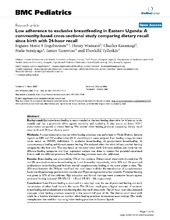Low adherence to exclusive breastfeeding in Eastern Uganda: A community-based cross-sectional study comparing dietary recall since birth with 24-hour recall
Engebretsen, Ingunn Marie S.; Wamani, Henry; Karamagi, Charles A. S.; Semiyaga, Nulu; Tumwine, James K.; Tylleskär, Thorkild
Peer reviewed, Journal article
Published version
Permanent lenke
https://hdl.handle.net/1956/2212Utgivelsesdato
2007-03-01Metadata
Vis full innførselSamlinger
Originalversjon
https://doi.org/10.1186/1471-2431-7-10Sammendrag
Background: Exclusive breastfeeding is recommended as the best feeding alternative for infants up to six months and has a protective effect against mortality and morbidity. It also seems to lower HIV-1 transmission compared to mixed feeding. We studied infant feeding practices comparing dietary recall since birth with 24-hour dietary recall. Methods: A cross-sectional survey on infant feeding practices was performed in Mbale District, Eastern Uganda in 2003 and 727 mother-infant (0–11 months) pairs were analysed. Four feeding categories were made based on WHO's definitions: 1) exclusive breastfeeding, 2) predominant breastfeeding, 3) complementary feeding and 4) replacement feeding. We analyzed when the infant fell into another feeding category for the first time. This was based on the recall since birth. Life-table analysis was made for the different feeding categories and Cox regression analysis was done to control for potential associated factors with the different practices. Prelacteal feeding practices were also addressed. Results: Breastfeeding was practiced by 99% of the mothers. Dietary recall since birth showed that 7% and 0% practiced exclusive breastfeeding by 3 and 6 months, respectively, while 30% and 3% practiced predominant breastfeeding and had not started complementary feeding at the same points in time. The difference between the 24-hour recall and the recall since birth for the introduction of complementary feeds was 46 percentage points at two months and 59 percentage points at four months. Prelacteal feeding was given to 57% of the children. High education and formal marriage were protective factors against prelacteal feeding (adjusted OR 0.5, 0.2 – 1.0 and 0.5, 0.3 – 0.8, respectively). Conclusion: Even if breastfeeding is practiced at a very high rate, the use of prelacteal feeding and early introduction of other food items is the norm. The 24-hour recall gives a higher estimate of exclusive breastfeeding and predominant breastfeeding than the recall since birth. The 24-hour recall also detected improper infant feeding practices especially in the second half year of life. The dietary recall since birth might be a feasible alternative to monitor infant feeding practices in resource-poor settings. Our study reemphasizes the need for improving infant feeding practices in Eastern Uganda.
